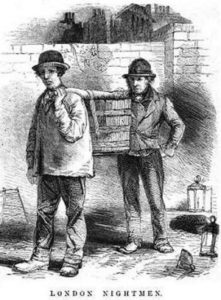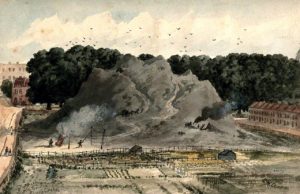
I struggled a bit with what category to place laystalls under, but ultimately decided sanitation was a health category…and laystalls were definitely not a “hot” spot.
We get a fair amount of hits on our bodily function/bathroom posts including: questions about indoor bathroom functions, rooms for retiring or the necessary, and withdrawing rooms. So I figured I was probably not the only one wondering about where the solids, particularly in the city, ended up.
So imagine my delight when, during developing our Regency Cant dictionary/thesaurus, I came upon the word laystall.
Laystalls were originally holding areas for cattle before going to market that evolved into also storage for waste (including human waste). Laystall Street is a prevalent name in many cities, including several in London, which mark original laystall sites.

A laystall, King’s Cross, painted 1837
General garbage and waste was collected and removed to laystall sotes as early as the thirteenth century in London. By the 16th, collections routinely occurred between 5 AM and 9 AM in the winter and 4 AM and 7 AM in the summer, before business of the day was commenced. Rubbish was placed in tubs, boxes, and/or baskets on the street, usually overnight, to be ready for collection (Hounsell, 2013).
Many affluent homes had cesspits on property that could contain some of the privy waste. Cesspits were up to 20 feet deep holes that were covered with wood or flagstones, and if maintained, did not have to be emptied annually or even every other year (https://historyhouse.co.uk/articles/nightman.html). However, most cesspits or cesspools were not well maintained and often resulted in leaking that good even fill up a neighboring basement.
The Nightman, or night soil remover, was in charge of going to the cesspit or cesspoil to empty it. They did this task in the night, usually in a group with a cart, and then taken to a Nightman’s yard or laystall.
These sites were often popular with scavengers, who would root around for valuables. The waste would be mixed with animal dung to produce fertilizer for farmers (https://historyhouse.co.uk/articles/nightman.html).
As London grew in size and industrialized, this was a Herculean effort that would be outpaced by pollution and result in a 1817 Act of Parliament to ensure garbage collection and street sweeping(Hounsell, 2013).
The modern London sewer system would not be developed until the Victorian era, so London mainly had storm drains that sent any waste or rubbish left on the streets into one of the nearby Rivers. This would result in pollution reforms(Regency Science and Invention: Pollution – Regency Reader (regrom.com)).
The modern sewer was not only in response to inventions of toliets, but also severe pandemic like cholera.
Hounsell, P. (2013) London’s Rubbish: Two Centuries of Dirt, Dust and Disease in the Metropolis. Amberley Publishing Limited.












Not a pretty topic, but important too know.
I agree! Hard to think of the work of Nightmen without a bit of a wrinkled nose.